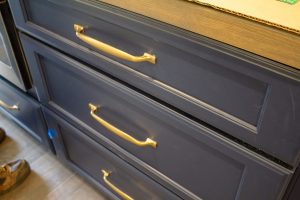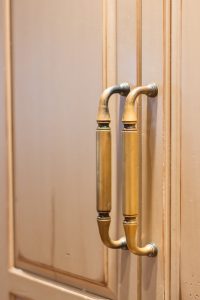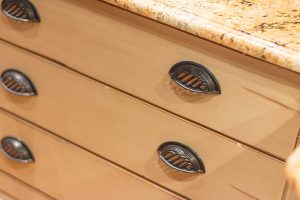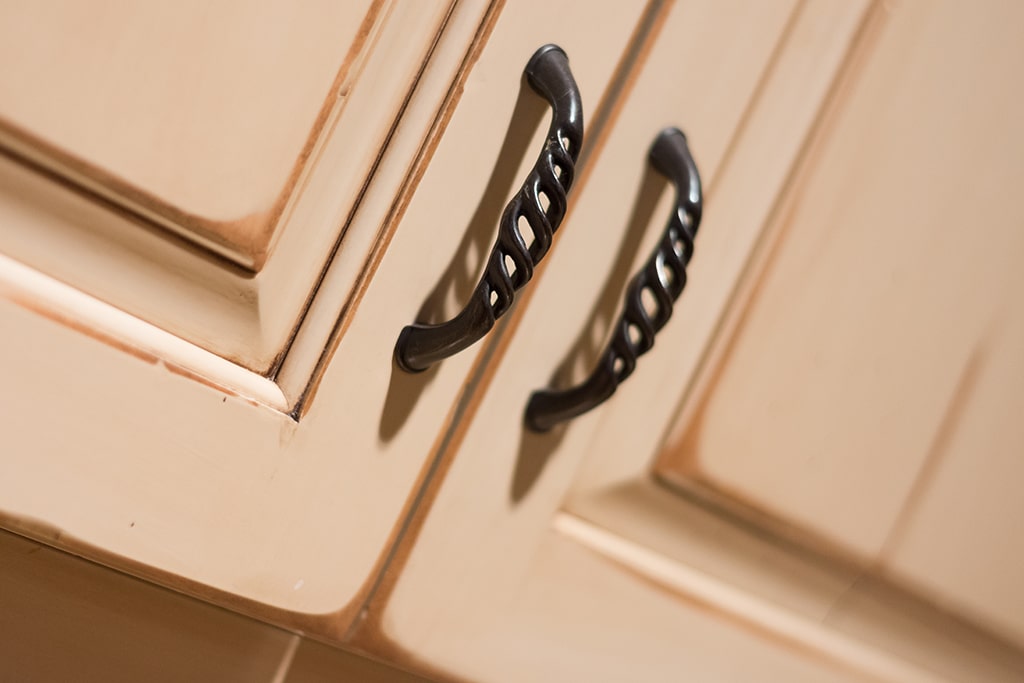Next Up in Our ‘Details Matter’ Design Series: Knobs & Pulls
It’s that time again — your chance to walk in my shoes and see just how much thought, deliberation and care goes into interior design work!
I say that somewhat lightheartedly, but it is all true. And yes, I’m talking about the Details Matter design series, where I delve into some of the nitty gritty of my job.
Hopefully, this series can give you some fresh ideas and insight into how a designer can help you elevate your surroundings.
Now, in our last post for this design series, we talked about all of the choices that need to be made when selecting lighting for your home. I bet some of you were surprised by the extent of it!
Well, the same thing goes for today’s topic.

Choosing hardware for your home, and especially for your kitchen, can be a fairly cumbersome process. But, I promise you, good decisions on this front can make a major impact on your overall look and home design. So it’s well worth the time it takes to get it right.
In fact, you’ve probably heard me refer to hardware as jewelry for your home. There’s a reason I keep turning back to this metaphor.
You know how you usually put your jewelry on last? And how a pair of earrings or necklace can totally make or break an outfit?
Hello, hardware.
You see, even though I usually make my hardware decisions after other elements of the room are in place, hardware is far from an afterthought. It’s actually more like the icing on the cake (not to go too heavy on the metaphors).
So, here we will go step by step through some of the factors I consider when selecting hardware. I’ll use the kitchen as an example, because it’s one of the rooms where hardware can have a major impact.
Hardware Style/Function
The first step in choosing hardware is considering the style of your cabinetry and overall look/feel of your kitchen.

Generally speaking, if you have a more traditional look to your cabinetry, you’ll want to stick to more traditional hardware. This is especially true if you have any sort of decorative edge profiles.
Glass knobs, drop handles, bin pulls, backplates or even window-sash pulls might be a good option here.
More modern or flat-paneled cabinets will typically look better with a streamlined, minimalist approach to hardware. Bar pulls or recessed pulls, for example, work well in a contemporary kitchen.
I say “typically”, however, because there are always exceptions to every design rule. In fact, hardware is one of those areas where mixing and matching styles can work really well — as long as you do it right! That’s where it can really be beneficial to have the help of a design expert.
Types of Hardware
So with all that said, here’s just a sampling of the types of hardware you can choose from:
Knobs There is a lot to choose from in the knob department. Depending upon the look you are trying to achieve, you could consider everything from a more traditional knob to a novelty or glass knob. Knobs can be a great option for lower cabinets. Of course, you could also use them on the uppers if you are striving for visual consistency. Knobs on drawers are less common, but not strictly forbidden. Remember, the design gods are very forgiving when it comes to hardware!
Bar Pulls Bar pulls are shaped like a handle and come in many different lengths. Because of this, and their overall utility, you will often see them sprinkled throughout a kitchen. More often these days, they are appearing on cabinets and drawers. On cabinets, you will see them placed vertically and on drawers you will see them placed horizontally. On wider drawers, you might use two bar pulls.
Recessed Pulls Recessed pulls are built into the cabinetry, and have a very streamlined look. They can go modern or vintage, depending upon their surroundings. Of course, because they are a part of the cabinetry you can’t easily add them to an existing kitchen or switch them out once you tire of them. So these should only be pursued after careful planning, ideally with the help of a designer.
Cup/Bin Pulls Cup or bin pulls come from an older era but are becoming increasingly popular as modern kitchens incorporate more farmhouse and vintage elements. These upside-down cup-shaped pulls are easy to open and have a distinct look. They work well with flat-paneled cabinets and less ornate surroundings.
Drop Pulls With drop pulls, a ring hangs from a mounted peg or plate. These are more unique and can help your cabinetry achieve a dressier, furniture-like look.
For an even more comprehensive run-down of all the options available to you, check out this Houzz article. As you can see, the possibilities are endless. And the style you pick can greatly influence the overall feel of your kitchen.
Considering Color and Finish
Now, once you’ve selected the type of hardware, you’ll want to fine tune your selections by considering color and finish. Here again, there are a lot of options. From oil rubbed bronze to brushed nickel or brass, or even pewter or rust, you can easily find your head spinning at this point in the process.

My advice is always to take that birds eye view and consider the overall look of your kitchen.
What is your dominant color? How about the general theme or style? What are you using for your lighting and window and door hardware?
The answers to these questions will help guide your choices here.
Now, one important note: it is ok to mix finishes in your kitchen. Mixed metals are no longer a design faux paus, in fact, just the opposite.
Remember that jewelry metaphor? Well, think about how often you now see people mixing silver and gold jewelry.
The same goes with hardware. The key, however, is to pick one dominant color/finish and then just one or two others to use as accents.
I’ve picked up some other tips along the way as well. For example, you don’t want to mix two metals that are within the same color family (say, a shiny chrome and a brushed nickel) because it could come off as a design error, rather than an intentional mismatch.
You’ll also want to use your dominant color/finish on the most prominent elements of your kitchen (say the cabinetry and lighting), then sprinkle the other one or two as accents (with your mirrors or faucet, for example).
And finally, at the risk of stating the obvious, you’ll want to be consistent within each hardware element or group. For instance, you wouldn’t want to use oil rubbed bronze on some of your lower cabinet knobs but then switch to pewter for your uppers.
For more tips on mixing metals with your hardware, check out this blog post.
Hardware Size/Placement

Finally — and this probably gets googled the most out of all of these hardware considerations — is the question of size and placement.
This can be tricky, and honestly, is fairly subjective. So I will give you my basic rules of thumb and then set you up with a few web pages that really nail the specifics of this and also include some very helpful diagrams and placement guides.
So, first of all, consistency is key here. To avoid a cluttered look, try to stick to one dominant size. If you are going to switch it up, do so in a way that makes sense and doesn’t disrupt the eye. For example, if you have vertical pulls on your cabinets, it may be ok if those are a different length than the horizontal pulls you use on your drawers. Or, you might also be ok with different lengths if they are in different parts of the room, where they aren’t competing with each other.
This rule applies even if your cabinet and drawer sizes vary quite a bit — in fact, in that case, it becomes even more important to have consistency in the size of your hardware. Because that is the factor that can and will tie everything together. If you have an oversized drawer, simply consider two pulls equidistant from the center, instead of one pull in the center.

Now, as I mentioned earlier, people tend to prefer knobs on cabinets and pulls on drawers. But vertical pulls on cabinets are becoming increasingly popular, so don’t automatically rule that out.
Still with me?
Ok, one final piece of advice before I send you off to some really well-researched posts on this topic.
I would highly, highly recommend taping out the pulls and knobs on your cabinet before making any purchases. In other words, cut a bunch of pieces of painters tape to the size of the handle or knob you are considering and start placing them on your cabinets and drawers.
It’s only when you see this big picture look that you will have a better sense of what does and does not work.
Then, before placing your full order, purchase just one or two pieces of each type of hardware that you are considering. Hold it up in your kitchen and make sure it is spot on aesthetically.
THEN, you can make your bulk purchase.
So now those links I promised you:
https://porchdaydreamer.com/right-length-cabinet-hardware-doors-drawers/
http://theknobbery.com/cabinet-hardware-sizing-guide
https://www.sandiegohardware.com/post/the-ultimate-guide-for-cabinet-hardware-placement-and-sizing
https://www.studio-mcgee.com/studioblog/2017/1/26/hardware-placement-guide
That’s All For Now

There you go! I hope you’ve found this post helpful. And remember, I’m only a phone call or email away if you’d like more ideas or help beyond what I offer in this design series. A lot of this comes down to trial and error, and after years in the business, I’ve gotten a good feel for where you can take risks and where it makes sense to stick to the traditional design rules.

